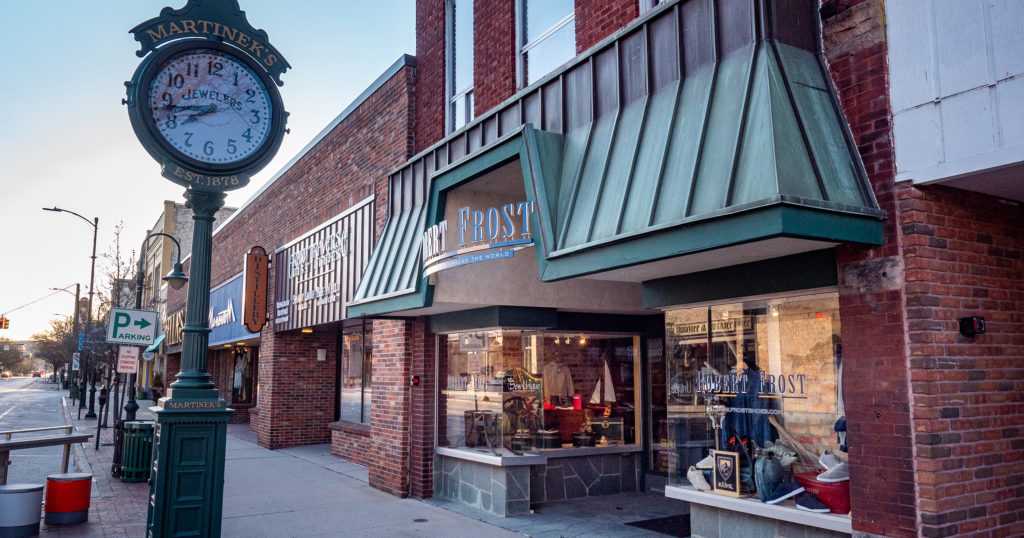Connecting the Dots: Keeping a Main Street in Michigan Alive


Petula Clark told us it’s where we could forget all our troubles and cares, but there is little doubt that the pandemic created many dilemmas for that slice of town we know and love called “downtown.”


And the heart of downtown in most towns or small cities is its “Main Street” – a thoroughfare where notable and important things happen, and where established, prosperous businesses tend to be located. COVID-related curveballs for such businesses included masking, social distancing, temporary shut-downs, reduced hours and capacities, and people going out less.
COVID-19’s impact on small businesses and Main Street is well documented. According to the National Center for Biotechnology Information, from February to April 2020, the number of active business owners in the United States declined by 3.3 million or 22%. May and June of 2020 were also dismal, with active small business owners down by 15% and 8%, respectively. From a financial standpoint, QuickBooks reported that April 2020 was small business’s cruelest month, with a 22% drop in revenue representing losses of $4.6 billion compared to before the pandemic.
Yet, many prized “Main Streets” not only survived, but thrived. Amy Shamroe is a commissioner in Traverse City, Michigan, a town with a notable Main Street (actually called Front Street), nestled in the state’s northwest corner. Lodged somewhere between the ring finger and pinkie of Michigan’s mitten-like shape, Traverse City’s proximity to Lake Michigan grants it mile upon mile of sugar-sand beach and water-related activities. But when COVID-19 uncertainty threatened the 400 small businesses that call Front Street home last year, leaders mobilized quickly to keep it going.
Shamroe spoke with “This Is Capitalism’s” Grace Williams about what keeping Main Street alive meant for this town that saw about 3.3 million tourists in 2013 and whose general population hovered around 15,500 in 2019. Edited excerpts are below.
Q: What was downtown like prior to COVID-19?
A: Over the past 20-plus years, a lot of effort was put into taking it from a place that closed down at 6 p.m. to make it over into more of a destination. We can also provide a center for people who want to experience the surroundings and then come back to a nice hotel or restaurant or to grab some food from a food truck and sit on the beach to enjoy it. Our small businesses inter-connected to each other and it became a really thriving place.
Q: When COVID became more than just a two-week blip, how did downtown Traverse City respond?
A: Our Downtown Development Association (DDA) worked with merchants to craft a plan that kept the downtown area in people’s minds. Very quickly, they mobilized to adapt to what was happening and changing. It wasn’t “everybody close down and shutter, and we don’t know what we’re going to do, and we hope we’re still here.”
Local ads appeared on social media to remind the community that although the circumstances were different, downtown merchants were still here. We also encouraged people to buy gift cards for downtown businesses, which could be purchased in any desired designation and used at any shop downtown later on when it felt safer to shop. For those who ventured out, we put several parking meters out of service, allowing customers to drive up, park for free, and wait for merchants to deliver their orders curbside.
Q: Restrictions eased up in summer 2020. What happened then?
A: Businesses could provide outdoor seating or allow masked customers to enter at a reduced capacity, so we closed a portion of Front Street off to vehicles, making it a safe, walkable stretch of town to allow social distancing and still have people be out and about. The closure of Front Street to traffic meant that restaurants could have more seating capacity and it allowed them to put tables and chairs out in the street and in front of their shops. Even though they were dealing with a reduced capacity, they were able to adapt.
Q: How did the businesses do last year?
A: Only a handful suffered a COVID-related fate. One was a yoga studio that couldn’t open for obvious social distancing reasons and a couple of others closed because the owners had been thinking of retiring and took the opportunity to make the switch.
Q: What are some of the advantages a Main Street could have over a city or even a mall?
A: In terms of last summer, the lower capacity made being out and about feel safer. You’re not going into a city where you feel like you’re crammed against people every time you turn around. You’re going to a place that feels quaint and manageable.
Q: Everyone had to pivot over the past months to make things work. What is something positive we haven’t discussed yet that you have seen come out of the pivot?
A: The town’s community theater, for instance, put on plays in its parking lot under a giant tent rather than inside the building, pushing the al fresco experience beyond eating and drinking.
As we get back to “normal,” some of this past year’s experience has allowed us to stretch and bend, maybe change things that have been done the same way for years and years.
Q: How are things looking this year?
A: This summer, thanks to vaccines, social distancing, and overall ease in fears, we expect more visitors to the area. We saw an increase in seven-day-a-week tourism in early May this year, which was earlier than usual. It continued through Cherry Festival, our big festival that just wrapped in July. We noticed that interest in downtown businesses stayed strong, even with the festival attractions, which sometimes diverts attention and foot traffic from the nearby businesses on Front Street.

